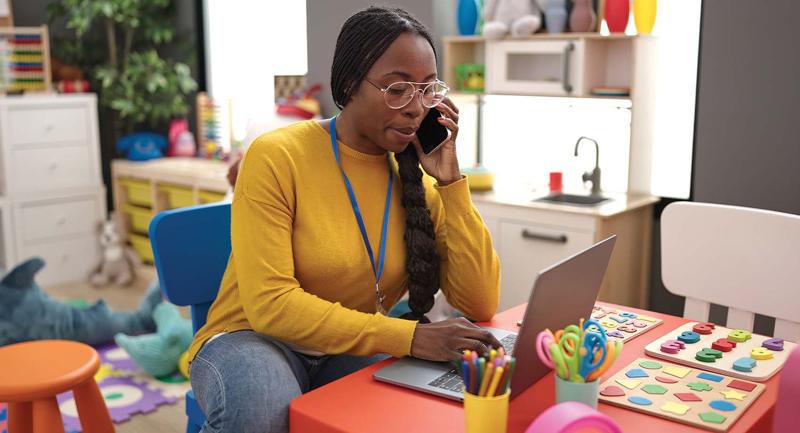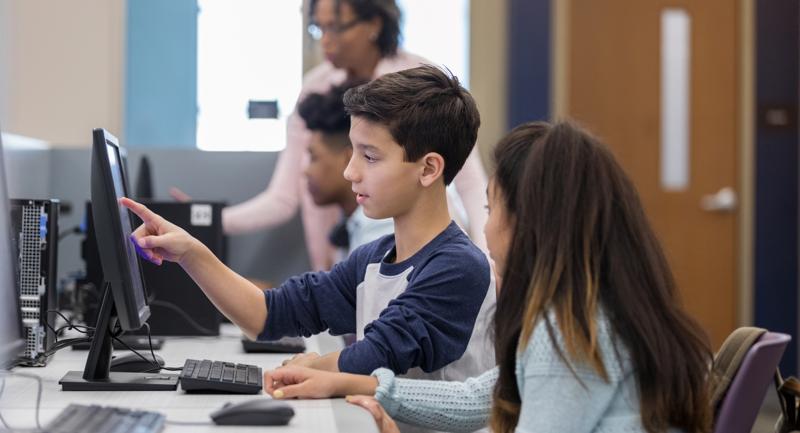A middle school addresses the digital divide by providing families with low-cost laptops—and training that connects technology to community needs.
At 4:00 p.m., as Lilla G. Frederick Middle School wraps up its academic day, opportunities for learning are hardly winding down. Instead of heading home, a group of students meander to Grace Coleman's classroom. Coleman, a 6th grade humanities teacher, will facilitate this afternoon's "class," but the students who greet her as she sets laptops on tables will not be passive learners; they will be coparticipants and teachers—of their parents. Each middle schooler's mother, father, or guardian will gain skills—and get access to prized technology resources—that will help the whole family advance its middle schooler's academic achievement. As parents trickle in, each adult sits next to his or her child and prepares for a session of Tech Goes Home.
Tech Goes Home (TGH), a citywide program initiated by Boston's mayor Thomas M. Menino, has to date provided computers to more than 5,000 families of low-income students in 43 Boston public schools. Through attending technology training sessions at their local schools, recipients first learn to use these computers to meet important education and life goals. After 25 hours of classes, families can purchase a computer for $50. At Lilla G. Frederick, all students are welcome to participate, but sign-up is first-come, first-served, and there isn't always room for all students in a particular semester.
This leg up to computer access at home is necessary to provide students with equal opportunity to excel in secondary school and beyond. As in many high-poverty zones, a large number of homes in the surrounding community of Dorchester have no computer access, no adults skilled in using digital tools for personal learning, and little hope of acquiring either one.
Students at Lilla G. Frederick come from a community that has historically been at risk of academic failure. Our school's population is 56 percent black, 38.2 percent Hispanic, 3.4 percent white, 1.6 percent Asian, and .5 percent American Indian. At least three different languages—Spanish, Somali, and English—are spoken in various homes. The neighborhood's average household income is $22,700—35 percent lower than the average Boston salary. Eighty-seven percent of our students receive free or reduced-price lunch, and 30 percent receive special education services. Approximately one-third of students perform below grade level; in 2008, 80 percent of the school's 7th graders scored in the "needs improvement" or "warning" categories on the Massachusetts standardized tests.
This combination of demographic complexity, socioeconomic challenges, and low academic performance is not unusual for an urban community. What's unusual is the multifaceted approach—combining academic rigor with close attention to social, financial, and career support for students and parents—that Frederick takes to address the community's issues. As a university researcher who has assisted with Frederick's Tech Goes Home parent classes, I've seen the school's successful approach firsthand.
Frederick provides students with a rigorous curriculum that reflects the kind of content and instruction often found in wealthier communities. The school grounds its curriculum and pedagogy in inquiry, exploration, experiential learning, and the chance to make connections among various learning areas. Digital technology is central to this inquiry focus. Teachers use technology daily to support learning. As a result, students see technology as integral to constructing knowledge.
In one project, for instance, Frederick students used iMovie and GarageBand software to create digital stories linking their personal experiences to the Bill of Rights. One group's story talked about how the right to bear arms plays out in Boston with regard to gang shootings; group members shared this presentation at a community meeting. In another class, students used the Internet to research the needs of families in Haiti after the 2010 earthquake and to connect to and raise funds for an orphanage.
The school gives each student a laptop to use in school. Frederick originally acquired the laptops through a pilot project funded by the state legislature, and they are now maintained through the school's general budget. Although students avidly use technology during the school day, they cannot bring their laptops home. It's dangerous to carry laptops in a neighbor hood in which gangs, crime, and violence are prevalent. This presents problems for families who do not own a computer; homework often requires access to technology, and students are used to learning and studying digitally.
Frederick decided to address this inequity by designing a comprehensive school-community partner ship. Once families have gone through Tech Goes Home and purchased a laptop for $50, that computer stays in the student's home and the student continues to use the school-owned laptop in school.
We use several routes to help families afford the monthly fee for Internet connectivity. A group called OpenAir Boston has installed a wireless network for families in low-income areas that costs only $10 per month. This network reaches many of our kids' homes; for those homes it doesn't, the school works to help families find inexpensive options or nearby "hot spots" where they can tap into a free wireless network. We are also advocating for Internet companies to alter their pricing structures to accommodate low-income customers.
The effort goes beyond placing computer hardware in homes, however. Our partnership not only addresses crucial academic needs, but also responds to social, economic, language, and institutional challenges that our diverse neighborhood faces.
Traditionally, school-community partnerships either concentrate on improving academic performance, student behavior, and attendance rates (Henderson & Mapp, 2002) or on addressing common challenges that low-income immigrant families face, such as inadequate finances and accommodating to a new culture (Blue-Banning, Summers, Frankland, Nelson, & Beegle, 2004; Cooper & Christie, 2005).
Rather than falling into the usual stance of overlooking the resources that families bring, Frederick embraces parents as full partners in Tech Goes Home. Teachers offer classes in multiple languages so all parents can participate. Beyond computer access, the project's goals include increasing home-school communication, teaching parents computer applications that their children frequently use, and introducing parents to financial and career-related computer programs. These goals reflect needs that Frederick's families have identified; meeting those needs helps families contribute to their children's education.
The school's partnership philosophy is rooted in Warren's (2005) concept of relational power, which focuses on building networks of relationships—between parents and children, parents and teachers, families and the school, and so on—that increase both school and community success. Networks help families navigate economic, social, and political realities. For one thing, by developing relationships with teachers and fellow parents, families experience cultural norms beyond their own. As families take advantage of resources and get to know more about their local school and those who work there, they learn how a public school functions and how teachers communicate, cultural knowledge that is particularly significant for immigrant families. Parents become more comfortable in following student progress and supporting their children, teachers, and the school. Ultimately, they gain a sense of empowerment.
Each week, students teach parents computer skills—including saving and locating files, using e-mail, and searching the Internet—in ways that connect to parents' lives or their involvement with the school. For example, we have parents practice using Microsoft Word and Excel by keeping a record of their child's progress in school and of their own progress in learning computer skills. Kids teach parents web searching strategies by helping them pursue information about their career goals.
Parent participants don't simply learn from the school; the school also learns from them. As they collaborate with teachers, parents reveal how they view the school and community roles (including their own). They also show something of their parenting practices and parent-child relationships. This gives teachers insight into how the school can better relate to the student population and shape school activities to support families.
As parents gain computer skills, they pursue opportunities that advance their children's success. One potent activity is our parent-child team research project. Research topics usually focus on exploring career opportunities and individual goals. For example, one 8th grader and her parent used digital applications to research colleges with good premed programs and generous financial aid because, as the girl put it, "My dream is to become a doctor. … College is getting closer and closer." Another team searched the Internet for financial management tools and tried out such applications as Excel to learn how to create a budget, set up a savings plan, and calculate how to save for a down payment on a house.
Such meaningful projects motivate participation and help adults internalize new skills. As students work with their parents, they gain early exposure to navigating financial systems—setting up checking and savings accounts, securing loans, and so on.
For some parents, participation supports their current—and future—career growth. One mother who is attending college uses the laptop acquired through Tech Goes Home for her coursework, as well as to keep up with her daughter's grades. Another parent noted, "I knew a lot about the computer in terms of word processing and publishing, but I wanted to learn PowerPoint … a lot of jobs I'm going for wanted me to do PowerPoint, and I didn't have any experience on it."
Many parents said that without Tech Goes Home, they could not have obtained the computers or the training because it simply was not in the budget. Data from the city of Boston showed that in 2009, only 30 percent of households in the school's neighborhood had broadband Internet access.
The project uses technology access to strengthen relationships between parent and teacher, parent and child, and—for some—between immigrant and home country.
All Frederick teachers have e-mail accounts and in training sessions, students help their parents set up their own e-mail accounts, generally through Google's Gmail. Most parents give their children's teachers their e-mail address. Both parents and students realize that this means parents can talk to teachers anytime and know how their child is performing in school. These tightened bonds between teacher and parent not only improve student behavior, but also increase student performance and parental support.
Gmail applications support Frederick families who don't speak English. At least one mother uses Google translator to translate her e-mails to her child's teacher into English and to translate the teacher's responses back into Spanish.
Such examples show that digital communication jump-starts the parent-child dialogue around school behavior and academics. What is fascinating is how learning computer use from one's child also shapes the parent-child relationship. Many parents openly admit to computer illiteracy. More often than not, the students become their teachers at home as well as within Tech Goes Home sessions. In this power-shifting dynamic, the young people gain self-confidence, and parents learn to see their children in a new light. For example, as students show their parents how to create a spreadsheet of a household budget in Excel, parents come to see that their children not only have a useful skill, but also understand how to keep track of how they spend money.
Some participating immigrant families spoke of wanting to strengthen ties to their home countries. One application that parents learn to use is Skype, a free online computer-to-computer telephone connection that enables speakers to see one another as they talk. Although training sessions focus on using Skype for school-home communications, at least one family saw its value for connecting to the Dominican Republic and began using it to communicate with family and friends back home.
As Frederick families file out at the end of each semester of Tech Goes Home, parents' and students' beaming smiles exude a sense of accomplishment. Although the program has been going only three years and it's premature to measure whether neighborhood parents have made socioeconomic gains, the school has seen improvements in students' achievement since launching the partnership.
Between June 2008 and July 2009, for instance, the number of 6th graders failing math at Frederick decreased by almost 50 percent and the number of 7th graders failing English language arts decreased by 20 percent. It's interesting to note that the school's student mobility rate went from 15.1 percent to 9.1 percent.
Tech Goes Home offers one model for simultaneously closing the gap in low-income students' access to technology, using technology to strengthen school relationships, and building parents' capacity. As the program continues at Lilla G. Frederick and school leaders learn more about students and families, parents will continue to create paths toward their children's success—and their own.
References
•
Blue-Banning, M., Summers, J., Frankland, N., Nelson, L., & Beegle, G. (2004). Dimensions of family and professional partnerships: Constructive guidelines for collaboration. Council for Exceptional Children, 70, 167–184.
•
Cooper, C. W., & Christie, C. A. (2005, October). Evaluating parent empowerment: A look at the potential of social justice evaluation in education. Teachers College Record, 107, 2248–2274.
•
Henderson, A. T., & Mapp, K. L. (2002).A new wave of evidence: The impact of school, family, and community connections on student achievement. Austin, TX: Southwest Educational Development Laboratory.
•
Warren, M. R. (2005, June). Communities and schools: A new view of urban education reform. Harvard Educational Review, 75, 133–173.









